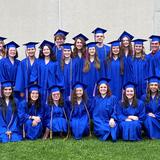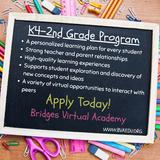Serving 747 students in grades Prekindergarten-12, Bridges Virtual Academy ranks in the top 50% of all schools in Wisconsin for overall test scores (math proficiency is bottom 50%, and reading proficiency is top 20%).
The percentage of students achieving proficiency in math is 40% (which is equal to the Wisconsin state average of 40%). The percentage of students achieving proficiency in reading/language arts is 56% (which is higher than the Wisconsin state average of 41%).
The student-teacher ratio of 18:1 is higher than the Wisconsin state level of 13:1.
Minority enrollment is 20% of the student body (majority Hispanic), which is lower than the Wisconsin state average of 33% (majority Hispanic).
Quick Facts (2025-26)
- School Type: Online School/Charter School
- Grades: Prekindergarten-12
- Enrollment: 747 students
- State Accredited: Yes
- Live Instruction: Yes
- Rolling Enrollment: Yes
- Student-Teacher Ratio: 18:1
- Minority Enrollment: 20%
- Graduation Rate: ≥90% (Top 50% in WI)
- Math Proficiency: 40% (Top 50%)
- Reading Proficiency: 56%
- Source: National Center for Education Statistics (NCES), WI Dept. of Education
School Overview
Bridges Virtual Academy's student population of 747 students has stayed relatively flat over five school years.
The teacher population of 41 teachers has grown by 41% over five school years.
School Type
Grades Offered
Grades Prekindergarten-12
(Exclusively virtual)
(Exclusively virtual)
Total Students
747 students
Gender %
Total Classroom Teachers
41 teachers
Year Founded
2012
State Accredited Program
Yes
Personalized Content
Yes
Live Instruction
Yes
Rolling Enrollment
Yes
Flexible Class Schedule
Yes
Accelerated Offerings
Yes
Classes for Credit/Part Time Options
No
Dedicated College Counselor
No
Tutoring/Mentoring
No
Community Clubs/Activities Offered
Yes
School Calendar
Last Day of School
Sat. May 16, 2026
School Motto
Providing a PERSONALIZED, virtual education program that develops students into skilled, independent learners.
School Rankings
The diversity score of Bridges Virtual Academy is 0.35, which is less than the diversity score at state average of 0.53. The school's diversity has stayed relatively flat over five school years.
Math Test Scores (% Proficient)
40%
40%
Reading/Language Arts Test Scores (% Proficient)
(18-19)56%
41%
Student-Teacher Ratio
18:1
13:1
American Indian
n/a
1%
Asian
3%
4%
Hispanic
6%
14%
Black
2%
9%
White
80%
67%
Hawaiian
1%
n/a
Two or more races
8%
5%
All Ethnic Groups
Graduation Rate
≥90%
90%
Eligible for Free Lunch (20-21)
30%
38%
Eligible for Reduced Lunch
8%
4%
School Statewide Testing
School District Name
Extracurriculars
Total ExtracurricularsTotal Extra-curric.
3 extracurriculars
ExtracurricularsExtra-curric.
Club or Organization:
National Honor SocietyStudent Council
Student Newspaper
Source: National Center for Education Statistics (NCES), WI Dept. of Education
School Notes
- Enroll your student and experience the benefits of a Bridges Virtual Academy education. BVA's low student-teacher ratio, strong family partnerships, academic enrichment opportunities, and community connections have resulted in a proven track record of student academic success and high parent satisfaction. The BVA educational program grows and adapts along with your children, starting with our youngest learners at K4 and moving through elementary, middle and high school, developing students into independent learners. BVA families are a part of a school that truly values each student by reaching beyond the screen to provide a well rounded and rich educational experience.
Profile last updated: 07/07/2025
Frequently Asked Questions
What schools are Bridges Virtual Academy often compared to?
Bridges Virtual Academyis often viewed alongside schools like Rural Virtual Academy by visitors of our site.
What percent of students have achieved state testing proficiency in math and reading?
40% of students have achieved math proficiency (compared to the 40% WI state average), while 56% of students have achieved reading proficiency (compared to the 41% WI state average).
What is the graduation rate of Bridges Virtual Academy?
The graduation rate of Bridges Virtual Academy is 90%, which is equal to the Wisconsin state average of 90%.
How many students attend Bridges Virtual Academy?
747 students attend Bridges Virtual Academy.
What is the racial composition of the student body?
80% of Bridges Virtual Academy students are White, 8% of students are Two or more races, 6% of students are Hispanic, 3% of students are Asian, 2% of students are Black, and 1% of students are Hawaiian.
What is the student-teacher ratio of Bridges Virtual Academy?
Bridges Virtual Academy has a student ration of 18:1, which is higher than the Wisconsin state average of 13:1.
What grades does Bridges Virtual Academy offer ?
Bridges Virtual Academy offers enrollment in grades Prekindergarten-12 (Exclusively virtual).
What school district is Bridges Virtual Academy part of?
Bridges Virtual Academy is part of Merrill Area School District.
School Reviews
Review Bridges Virtual Academy. Reviews should be a few sentences in length. Please include any comments on:
- Quality of academic programs, teachers, and facilities
- Availability of music, art, sports and other extracurricular activities
Recent Articles

How Public Schools Support Students on Free / Reduced-Lunch Programs
Explore how U.S. public schools support students eligible for free or reduced-price lunch through nutrition, academic, and wraparound services in 2025.

Hidden Costs of Public Schools: Fees, Supplies & Extras
Explore the hidden costs in public schools—fees, supplies, extracurriculars—and how parents can plan for them in 2025.

Public School Funding 2025: What Families Should Know
Essential insights on public school funding in 2025—how it works, what’s changing, and what families should know to stay ahead.















